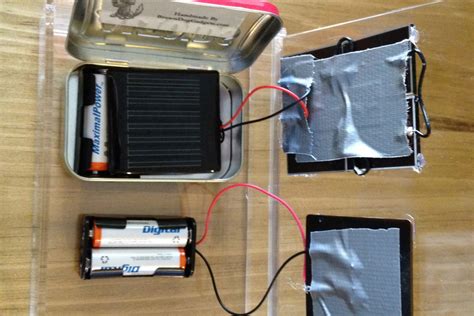What You’ll Need
Before we dive into the different types of DIY battery chargers, let’s go over the basic components you’ll need:
- Power supply (AC adapter or transformer)
- Rectifier diode
- Capacitor
- Resistor
- LED (optional, for indicating charging status)
- Breadboard or PCB
- Wires and connectors
Types of DIY Battery Chargers
1. NiCd and NiMH Battery Charger
Nickel-Cadmium (NiCd) and Nickel-Metal Hydride (NiMH) batteries are commonly used in portable devices like cordless phones and power tools. Here’s how to build a simple charger for these types of batteries:
Components
- 12V AC adapter
- Bridge rectifier (1A)
- 1000μF capacitor
- 100Ω resistor
- LED
- Battery Holder
Circuit Diagram
[Insert circuit diagram for NiCd/NiMH battery charger]
Step-by-Step Instructions
- Connect the AC adapter to the input of the bridge rectifier.
- Connect the positive output of the bridge rectifier to the positive terminal of the capacitor.
- Connect the negative output of the bridge rectifier to the negative terminal of the capacitor.
- Connect the positive terminal of the capacitor to the positive terminal of the battery holder.
- Connect the negative terminal of the capacitor to one end of the resistor.
- Connect the other end of the resistor to the negative terminal of the battery holder.
- Connect the positive terminal of the LED to the positive terminal of the battery holder.
- Connect the negative terminal of the LED to the negative terminal of the battery holder.
2. Lithium-Ion Battery Charger
Lithium-Ion (Li-Ion) batteries are popular in smartphones, laptops, and other portable electronics. Charging these batteries requires a more sophisticated approach due to their sensitivity to overcharging.
Components
- 5V USB power supply
- TP4056 Li-Ion battery charging module
- Lithium-Ion battery
- Battery holder
Circuit Diagram
[Insert circuit diagram for Li-Ion battery charger]
Step-by-Step Instructions
- Connect the USB power supply to the input of the TP4056 module.
- Connect the positive terminal of the Lithium-Ion battery to the positive output of the TP4056 module.
- Connect the negative terminal of the Lithium-Ion battery to the negative output of the TP4056 module.
- Place the battery in the battery holder.
The TP4056 module handles the charging process, ensuring the battery is charged safely and efficiently.
3. Lead-Acid Battery Charger
Lead-Acid batteries are used in cars, motorcycles, and other vehicles. These batteries require a higher voltage and current to charge properly.
Components
- 18V AC adapter
- Bridge rectifier (5A)
- 4700μF capacitor
- LM317 adjustable Voltage Regulator
- 220Ω resistor
- 1.2kΩ resistor
- LED
- Battery clamps
Circuit Diagram
[Insert circuit diagram for Lead-Acid battery charger]
Step-by-Step Instructions
- Connect the AC adapter to the input of the bridge rectifier.
- Connect the positive output of the bridge rectifier to the positive terminal of the capacitor.
- Connect the negative output of the bridge rectifier to the negative terminal of the capacitor.
- Connect the positive terminal of the capacitor to the input of the LM317 voltage regulator.
- Connect the adjustment pin of the LM317 to one end of the 1.2kΩ resistor.
- Connect the other end of the 1.2kΩ resistor to the output of the LM317.
- Connect one end of the 220Ω resistor to the output of the LM317.
- Connect the other end of the 220Ω resistor to the negative terminal of the capacitor.
- Connect the positive output of the LM317 to the positive battery clamp.
- Connect the negative terminal of the capacitor to the negative battery clamp.
- Connect the positive terminal of the LED to the positive battery clamp.
- Connect the negative terminal of the LED to the negative battery clamp.
Safety Considerations
When working with batteries and electrical components, always prioritize safety:
- Wear protective gear, such as gloves and safety glasses.
- Work in a well-ventilated area.
- Ensure proper polarity when connecting components.
- Use appropriate wire gauges and fuses to prevent short circuits and overheating.
- Never leave charging batteries unattended.

Frequently Asked Questions (FAQ)
- Can I use these DIY battery chargers for any battery size?
-
The chargers outlined in this guide are designed for specific Battery Types and voltages. Always ensure that the charger you build is compatible with the batteries you intend to charge.
-
How long does it take to charge a battery using a DIY charger?
-
Charging times vary depending on the battery type, capacity, and the charger’s output current. Generally, smaller batteries like NiCd and NiMH may take 1-2 hours, while larger batteries like Lead-Acid can take several hours to fully charge.
-
Can I modify these chargers to output higher currents for faster charging?
-
It is not recommended to modify the chargers to output higher currents than designed. Doing so can lead to overheating, damage to the components, and potentially cause fires or explosions.
-
How do I know when the battery is fully charged?
-
The LED included in the charger circuits serves as a charging indicator. When the battery is charging, the LED will be lit. Once the battery is fully charged, the LED will either turn off or change color, depending on the specific design.
-
Can I use these chargers for rechargeable alkaline batteries?
- No, rechargeable alkaline batteries require specialized chargers and should not be charged with the DIY chargers described in this guide. Attempting to do so can result in damage to the batteries and potentially cause leaks or ruptures.
Conclusion
Building your own DIY battery chargers can be a rewarding and cost-effective project. By understanding the basic components and following the step-by-step instructions for each battery type, you can create reliable and efficient chargers for your devices. Always prioritize safety and ensure compatibility between the charger and the batteries you intend to charge. Happy charging!

No responses yet